#amazonian manatee
Explore tagged Tumblr posts
Text
I am a survivor of Florida, having gone to college there for 4.5 years. There's a lot (a LOT) to not like about Florida, but the wildlife is not one of those things. So for this Wet Beast Wednesday, I'm gonna talk about the most famous Florida resident, the manatee. And why stop there? I'll discuss all the sirenians in one go.
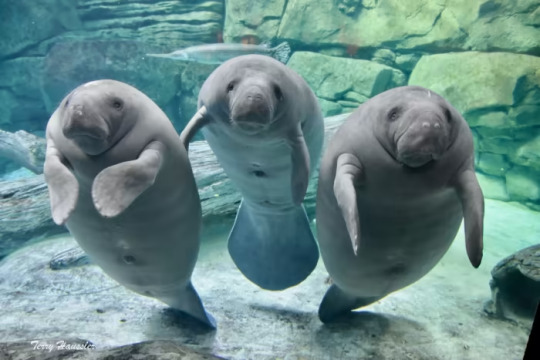
(image: three manatees facing the camera. They are rotund, resembling a potato in shape. Their heads are smaller and end in squarish snouts. They have two flippers at the front of the head. The tail is flat, wide, and round. They are grey all over)
The sirenians are a taxonomic order of marine mammals consisting of 4 living members: three species of manatee and the dugong. They are the only herbivorous order of marine mammals, a trait that has given the the nickname "sea cows". The name Sirenia comes from the sirens of greek myth. In the original story, the sirens were bird with the heads and breasts of women, but later stories turned them into mermaids and that's the version that's stuck. There are unconfirmed stories that European sailors (the most common story uses Christopher Columbus) mistook manatees for mermaids, which is why they're named after sirens.
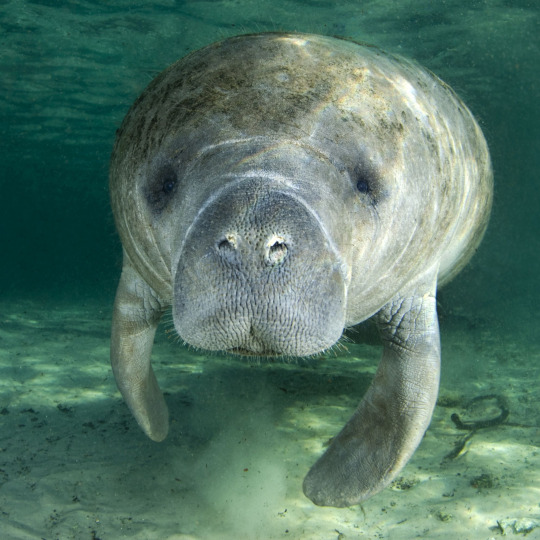
(image: a manatee facing the camera. Its face is visible, revealing two nostrils on a broad, flat shout covered in whiskers. It's eyes are located above the snout and are small and black. It is grey, but has patches of greenish algae growing on it)
Sirenians all have a pretty similar body plan. They are fusiform (bulky in the middle and narrower at the ends) and very bulky animals not built for speed. They don't ned to be fast (though are capable of short bursts of speed) because unlike other marine mammals, they are herbivorous. The vast majority of a sirenian's diet consists of sea grass and most of the rest is other aquatic plants. All species have been known to supplement their diet with invertebrates, mostly during times of poor food availability. When feeding, they move their snouts through the sediment, letting sensory bristles detect plants. They then use their flexible and muscular lips to pull up the sea grass, roots and all. While an individual can eat up to 15% of their body weight a day, they are known to seek out seagrass patches with higher nitrogen content instead of eating everything they can get. This reliance on seagrass limits the range of sirenians to shallow coastal areas, rivers, and estuaries in warm climates. Hearing and touch (with the bristles that cover their bodies) are their main senses. Their eyes are weak, making them almost blind. Sirenians are large, with the largest ever known, Stellar's sea cow, growing up to 10 meters (33 ft) and 11 tons. Mature sirenians are large enough to have no natural predators. Like all marine mammals not named sea otters, sirenians have a thick layer of blubber to keep them warm. Their bones are extremely dense and likely act as ballast to counteract the buoyancy of the blubber. In the marine mammal breath-holding competition, sirenians do pretty bad. They can hold their breath for about 15 minutes at max.
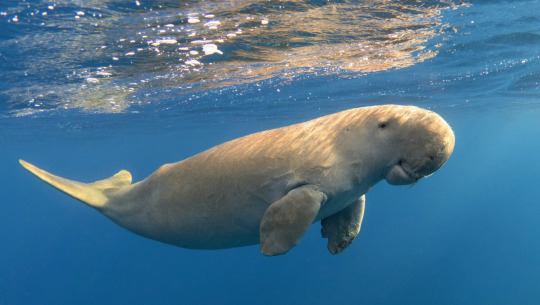
(image: a dugong. It is similar in appearance to a manatee, but skinnier. Its tail is a fluke with two points. Its head is larger and the snout and mouth point downwards)
Sirenian reproduction is somewhat poorly-understood. They only have a single calf at a time (with a gestation period of about a year) and mothers will raise them for one to two years. Calves mature quickly, reaching sexual maturity in around 2-5 years in manatees and 8 years in dugongs, though most females do not give birth until between 6 and 15 years. Their nipples are located behind the flippers, making a nursing calf appear to be sucking its mother's armpit. Sirenians are solitary animals who typically only congregate in groups when females are in estrus. Males are believed to compete for the right to mate and may engage in lekking. Lekking is when a male will claim a territory and mate with females in this territory while chasing opposing males out. Sirenians live long lives, with the oldest known individual being a female dugong that lived to 73. Despite how long they live, each female will only get pregnant a few times in her life.
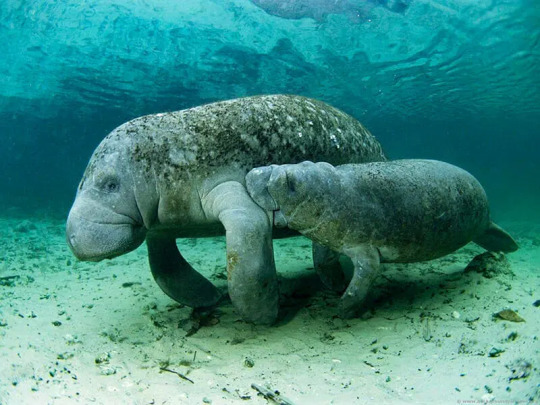
(image: a manatee mother with calf. The calf looks like a smaller version of the mother and is suckling, making it appear to be biting the mother's armpit)
As with all marine mammals, sirenians are descended from land mammals. The study of sirenian evolution has led to a surprising conclusion: the closest relatives of sirenians are elephants. It sounds weird, but there is substantial DNA evidence supporting this conclusion. In addition, the tusks of a dugong (see below) and flexible and prehensile lips of sirenians are based on the same structures as the tusks and trunks of elephants. It gets better, the next closest relative of both groups are the hyraxes, who look more like rodents than anything that should be related to an elephant or a manatee. All three are part of a clade called paenungulata, which is part of a clade called afrotheria. The other main group within afrotheria is afroinsectiphilia, which consists of aardvarks and various shrews. The afrotherian family reunions must be wild.

(image: a scientific diagram showing a cladogram of afrotheria and the groups within it. source)
The dugong (Dugong dugon) is the last surviving member of its family, which also included the now extinct giant Stellar's sea cow. The easiest way to tell a dugong apart from a manatee is its tail, which is shaped like a dolphin's fluke instead of the round tails of manatees. Internally, there are also multiple differences, many of them relating to the skull. The skull has a very distinct shape, with the upper jaw bending down at a sharp angle. The tip of the upper jaw has two short tusks emerging from it. These tusks are found in moth males and females, but develop differently. In males, they emerge when the calf reaches sexual maturity, while those of females only emerge later in life and sometimes not at all. It is believed that these tusks are used by males to fight over females, as males are often found with scars matching the shape of the tusks. Dugong teeth as simpler than those of manatees, being simple pegs. While manatee teeth will be replaced continuously through life, dugongs only get one set and have to make it count. Dugongs reach an average length of 3 m (10 ft) and 420 kg (930 lbs). Dugongs have the largest range of any sirenian, stretching from east Africa to the Solomon islands east of Australia. This range is fragmented rather than continuous and dugongs are separated into multiple isolated populations. The largest population is believed to exist in northern Australia.
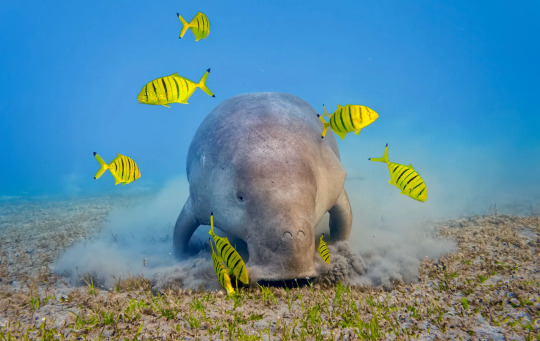
(image: a dugong feeding on seagrass, seen from the front. It's snout is being dragged through the sediment, leaving a cloud of dirt behind it. Small yellow fish surround it)
The west Indian manatee (Trichechus manatus) does not live in west India. It lives in North America. I dunno who named it, but you had one job. The species is divided into two subspecies: the Florida manatee (T. m. latriostris) found in the Gulf of Mexico and east coast of the United States, and the Antillean manatee (T. m. manatus) found in the Caribbean and down south to Brazil. The Antillean subspecies is much more poorly known compared to the Florida subspecies. The Florida manatee may be the most well-studied of all manatees due to the extensive conservation efforts regarding them since the 1970s. Like other manatees, the WI manatee has a round, paddle-like tail and fingernails on its flippers. Their diaphragms are divided into two hemidiaphragms, each of which contracts one lung. They have the northernmost territory of all manatees, which comes with some consequences. They are susceptible to stress and even death when exposed to water under 20 degrees C (68 F). They travel south during winter, usually to southern Florida, but conservationists still have to rehabilitate manatees harmed by cool water every year.
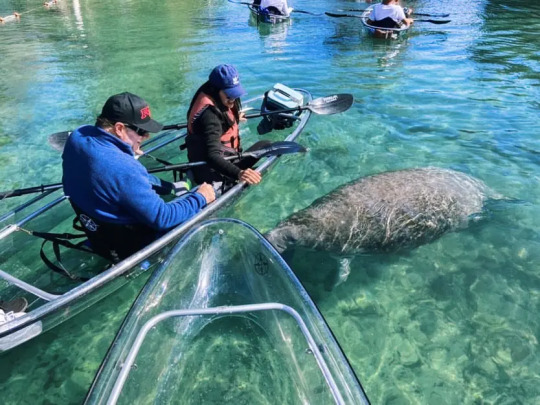
(image: tourists in transparent kayaks observing a west Indian manatee swim below them)
The Amazonian manatee (Trichechus inunguis) is the only sirenian that lives entirely in freshwater, residing in the Amazon river basin. They move seasonally inhabiting flooded areas during the wet season and lakes during the dry season. They fast during the dry season, subsisting off of their fat stores. There are believed to be multiple relatively isolated populations of Amazonian manatee, but studying them is difficult due to them preferring to live in areas away from humans. The Amazonian manatee is the smallest sirenian, reaching between 160 and 230 cm (5 ft 4 in to 7 ft 7 in) and 120 to 270 kg (265 to 595 lbs). Scientist Marc van Roosmalen has proposed the existence of a related species, the dwarf manatee, that lives only in one tributary of Aripuanã river, which is in the habitat range of the Amazonian manatee. Their existence is debated, but most manatee scientists think that they are misidentified juvenile Amazonian manatees.
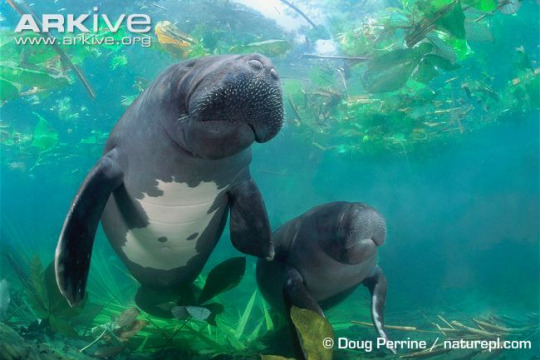
(image: an Amazonian manatee with calf, seen from ahead and below. they have the same body plan as the above images, but are a darker grey with a white patch on the stomach)
The African manatee (Trichechus senegalensis) is the only species found in the old world, in west Africa from Senegal to Angola. They occupy the largest range of habitats of all sirenians, from tropical islands to flooded forests, to offshore sand flats, to lakes and rivers. They will swim up river during the wet season and back down during dry season. Some isolated populations live exclusively in rivers, never venturing out to sea. They are the most omnivorous of the sirenians, seeking out invertebrates to eat and stealing fish from nets. Many cultural groups in their range consider the African manatee sacred, some saying they used to be people and that killing one requires paying a penance. Mami Wata, a water spirit revered in throughout west, central, and south Africa, has been identified with manatees by some folklorists.
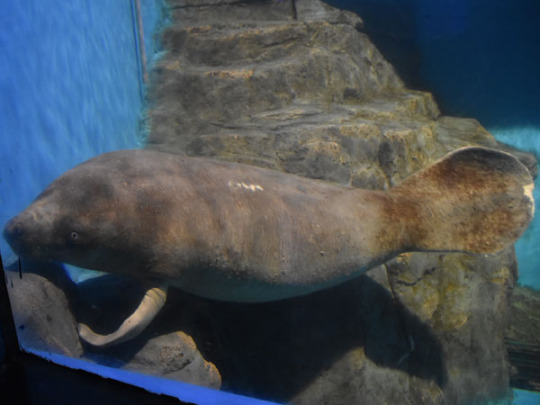
(image: an African manatee seen from the side in an aquarium. It looks almost identical to the west Indian manatee)
All sirenians are classified as vulnerable by the IUCN, except for the Antillean manatee, which is endangered. As they have few to no predators as adults, the primary threats for all sirenians come from humans. Boat strikes and getting tangled in nets kills and injures many individuals, possibly more than die of natural causes. This is not helped by them lacking fear responses to predators, meaning they don't flee from humans and boats. All species were historically hunted for their meat, blubber, and bones, reducing their populations. While all species are now legally protected, poaching and legal hunting by indigenous groups still occurs. They are also threatened by habitat loss as coastal development, pollution, and climate change reduces the range of seagrass. Damming has also reduced their ability to travel up rivers, cutting off valuable feeding ground. Learning about freshwater ecology will make you despise dams. In the United States, the west Indian manatee has become an icon of conservation, especially in Florida, where they have extensive legal protections. Controversially, the US government reduced their legal protections in 2017, much to the ire of many conservation groups. The manatee is the state marine mammal of Florida, presumably narrowly beating out dolphins and meth heads wandering around the everglades.

(image: two juvenile manatees who were abandoned by their mothers. They are being bottle fed by employees of the Cincinnati zoo. Ideally, they will be able to be released into the wild once weaned)
#wet beast wednesday#sirenia#manatee#dugong#west indian manatee#amazonian manatee#african manatee#marine biology#biology#zoology#ecology#animal facts#marine mammals
487 notes
·
View notes
Text

Amazonian Manatees are at risk for two main reasons: They have been hunted for their meat and oil; and their reproductive cycle is very slow, with the female carrying pregnancy for 13 months and having only one baby at a time, rarely twins. She also cares for them for 4 years before she can go and reproduce again. Both of these reasons have caused their population to decline a lot in the last decades… Some groups like AMPA and IPE are making an effort along with international help to save them, though!
#Aqua Facts With Zuma#Paw Patrol#Paw Patrol Zuma#Zuma Paw Patrol#Zuma#Manatee#Amazonian Manatee#Amazon Manatee#Peixe Boi#Peixe Boi Amazônico#Peixe Boi da Amazônia#Justice For Zuma
19 notes
·
View notes
Text

Inktober day 13: Amazonian manatee
#inktober#inktober 2023#art#ink#amazonian manatee#manatee#fish#banded leoprinus#angelfish#freshwater angelfish#cichlid
43 notes
·
View notes
Text

Amazonian Manatee by Shadowscapes - The Art of Stephanie Law
155 notes
·
View notes
Text
@manateemoon
apparently one of the predators of the amazonian manatee is the jaguar and now I am struggling to imagine a jaguar killing a manatee and dragging it up a tree without giggling
82 notes
·
View notes
Text
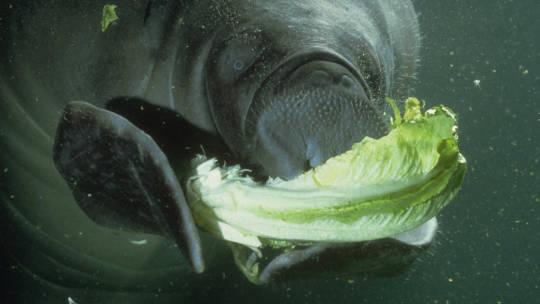


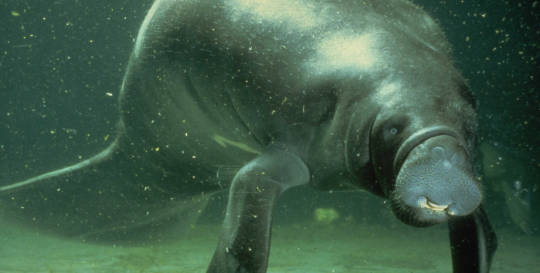
An Amazonian manatee (Trichechus inunguis) named Butterball horfing down an iceberg lettuce at the Steinhart Aquarium in roughly the 1970's (source)
63 notes
·
View notes
Text
Drying rivers boost illegal hunting, fishing in Amazon

Johnatan Santos, the director of environmental inspection at the Brazilian Institute for the Environment and Renewable Natural Resources (IBAMA), stated in an interview with TV Brasil that the drought aggravated by climate change has contributed to a rise in illegal hunting and fishing of endangered species in the Amazon.
“Because of the low water levels, it's easier for criminals to see the animals and capture them quickly,” he said.
The statement followed the seizure of a slaughtered Amazonian manatee (Trichechus inunguis) along the banks of the Tefé River in Amazonas state last Tuesday (24).
The operation promoted by the environmental agency also seized 422 kg of pirarucu meat (Arapaima gigas) being sold at the Tefé Municipal Fair, without proof of origin from authorized management.
Continue reading.
#brazil#brazilian politics#politics#environmentalism#environmental justice#amazon rainforest#image description in alt#mod nise da silveira
4 notes
·
View notes
Text

Part of the Capelobo Clan, these three help protect the waterways of the Amazon.
Iauara- Based on a lowland tapir and named after the cryptid tapire-iauara which translates to "tapir water nymph". Uses magic and is particularly powerful at spells relating to dreams and sleep. Performs rituals with the tsantsa.
Boto- Based on a river dolphin. He is fascinated by humans and can take human form. In folklore, boto encantado transform at night, but I might make it so that he can transform during the day or at will; I'm not sure yet, he'll definitely be a cute twink tho. His attitude towards humans sometimes puts him at odds with the clan leader, Juma, who is not fond of them.
Bebe- based on an Amazonian manatee. A big sweetheart baby that doesn't prefer to fight, but will use their massive body to defend friends, this tendency has resulted in some scars on the back. Everybody loves them, but Boto especially takes care of them (in folklore it's said that river dolphins are the guardians of manatees).
These are the other, and eponymous, members of the Capelobo Clan:

#gargoyles#gargoyles disney#disney gargoyles#disney's gargoyles#disney afternoon#toon disney#gargoyles oc#gargoyles ocs#Disney#tapire iauara#boto encantado#capelobo#tapir#river dolphin#manatee#my art
2 notes
·
View notes
Note
sirenians are just generally quite tough, and theyre notably faster than most people gove them credit for.
they typically have quite thick skin and fat layers, along with The Bone Torso, to the point where even amazonian manatees have few threats, though their dark coloration might be an additional defense.
the dugong is potentially the most predated of all sirenians, as while tiger sharks and crocodiles overlap with all extant sirenians (except the amazonian) south Australia is home to salties, which get a lot larger than american crocs, generally has more tigers than american coastlines, and the occasional leopard seal. orca are also more of an issue, for various reasons, which is why dugong are the fastest living sirenians, with fully fluked tails, and much rarer than manatees, with only a single species.
how do manatees even survive as a species if they're way too peaceful. somehow nothing wants to eat them. not gators or sharks or whales
it's quite simple, they're their ecosystem's version of a megafauna grazing mammal! they're simply too large for most predators to bother. they are, in fact, fucking huge.


see, manatees don't actually live out in the open ocean. they live in rivers, estuaries, and shallow seagrass bays like this:
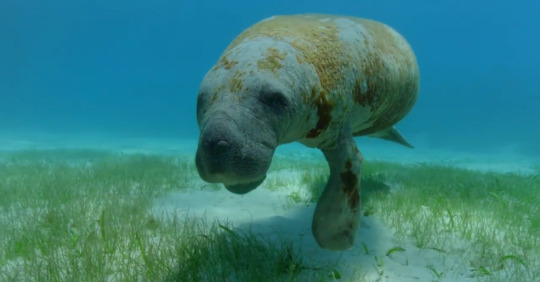
so the thing is, large macropredator sharks and superpredators like killer whales don't go here! they stay out in open deep water, so they never really cross paths with manatees in the first place.
there ARE sharks here, but they're small! adult manatees are completely out of their prey size range, and they're more interested in fish anyway.
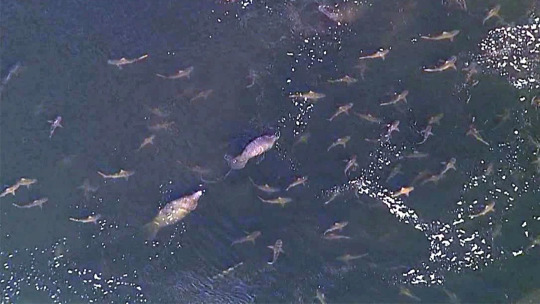
alligators do live here also, but even a very large alligator can't really dream of preying on an adult manatee! again, they're simply too big.
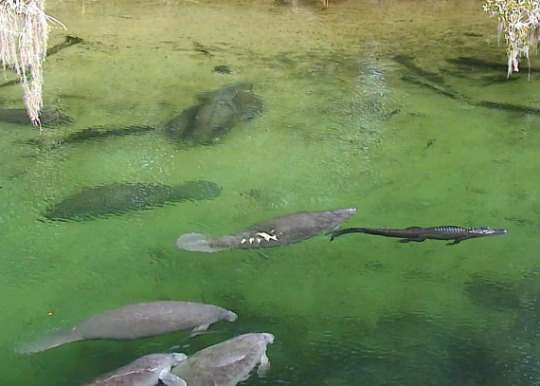
so, yeah. this is just another case of "this mammal is able to get away with being a gentle giant by simply growing too large for any predator in its area to touch" and I think that's beautiful.
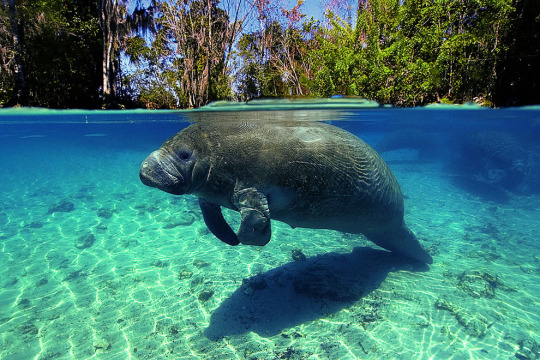
20K notes
·
View notes
Note
Your final choice for this round was manatees.
The smallest kind of manatees are the Amazonian manatees, and the largest are the West Indian Manatees. They are amazing creatures that have very thick skin that protects them from predators and boats.
Hope you are ready for round two.
Would you rather: Camels or Deers?
Oh this is amazing idk what i did to start this game but i hope it never ends, thank you for the information on manatees!!
For round two I think I'll start with deers
#i looove camels and i find them fascinating but there's a lot of deers where i live and i need to be able to face them if we cross paths#also#this is amazing#forget i said anything about nefarious intentions#this is grwat#i love you anon#🔎 anon#I REMEMBEREEEED#aiden asks#anon ask
0 notes
Text
UPDATE. Volunteer on Peru's Amazon Jungle
By Gabriela Fernanda Pineda Morán.
I arrived to Peru's Amazon Jungle a few days ago, and I’m staying here for two weeks. When I entered the jungle, the weather was very humid and hot, typical for this time of year. I remember sweating a lot. In September, the humidity makes the heat feel more intense, with temperatures ranging from 25°C to 32°C during the day. Even at night, it stays warm, and the air is thick with moisture.
During this week I've been staying in the northern Peru in Pacaya Samiria National Reserve which is known as the “Jungle of Mirrors” because of the reflective quality of its water systems. It’s one of the largest protected areas in Peru, rich in wildlife and home to pink river dolphins, manatees, and numerous bird species.

It's been such a plesure to be here helping on the reforestation efforts, which include planting trees, shrubs, and orchids, as well as removing non-native and invasive species of bamboo. I´ve also been observing and counting various species of birds, insects, amphibians, and primates. I haven't seen all the beautiful creatures yet, but I’m excited for what’s to come. For example the night walks, boat tours through the amazonian waters, and visiting indigenous communities.
The next week im going to the south to Tambopata National Reserve, renowned for its rich biodiversity. I'm very exited to go there because is home to hundres of animals including Capybaras.What we're doing thre is cleaning up the area and make sure the animals are enjoing their home.
1 note
·
View note
Text
UPDATE. Volunteer on Peru's Amazon Jungle
By Gabriela Fernanda Pineda Morán.
I arrived to Peru's Amazon Jungle a few days ago, and I’m staying here for two weeks. When I entered the jungle, the weather was very humid and hot, typical for this time of year. I remember sweating a lot. In September, the humidity makes the heat feel more intense, with temperatures ranging from 25°C to 32°C during the day. Even at night, it stays warm, and the air is thick with moisture.
During this week I've been staying in the northern Peru in Pacaya Samiria National Reserve which is known as the “Jungle of Mirrors” because of the reflective quality of its water systems. It’s one of the largest protected areas in Peru, rich in wildlife and home to pink river dolphins, manatees, and numerous bird species.

It's been such a plesure to be here helping on the reforestation efforts, which include planting trees, shrubs, and orchids, as well as removing non-native and invasive species of bamboo. I´ve also been observing and counting various species of birds, insects, amphibians, and primates. I haven't seen all the beautiful creatures yet, but I’m excited for what’s to come. For example the night walks, boat tours through the amazonian waters, and visiting indigenous communities.
The next week im going to the south to Tambopata National Reserve, renowned for its rich biodiversity. I'm very exited to go there because is home to hundres of animals including Capybaras.What we're doing thre is cleaning up the area and make sure the animals are enjoing their home.
0 notes
Text
Manatees Are The Underwater Gardeners Of The Amazon
Manatees Are The Underwater Gardeners Of The Amazon https://ift.tt/bSnLjVc Guterres-Pazin and colleagues discovered that Amazonian manatees act as important seed dispersers in Amazon floodplains. This finding elevates the ecological significance of these gentle giants and underscores the need for their conservation. The researchers analyzed 96 manatee faecal samples collected from Lake Amanã during an extreme drought in October 2023. They found viable seeds and even seedlings of various aquatic plants in the samples. The most common species was Luziola spruceana, a grass that grows rapidly during low water periods. To determine seed viability, the team used a special dye test. They also observed seedlings growing directly from the faecal matter. This proves that manatees can transport seeds over long distances during their seasonal migrations, helping plants colonize new areas. The study builds on previous research about manatee diets and migration patterns. It reveals a new ecological role for these animals, showing they contribute to plant diversity and ecosystem health in ways we didn’t fully understand before. The synchronization of herbaceous plant fruiting and the migratory behavior of the manatee with the flood pulse facilitates seed dispersal across diverse Amazonian environments. Thus, beyond their recognized roles in fertilizing water and soil and stimulating plant productivity, Amazonian manatees significantly contribute to the maintenance and genetic diversity of aquatic plants. Gil Guterres-Pazin, M., Lopes, A., Pazin, V.F.V., Garcia de Santana, D., Marmontel, M., Fernandez Piedade, M.T. (2024). A giant gardener of the Floodplains: The Amazonian manatee. Journal for Nature Conservation, 126708. https://doi.org/10.1016/j.jnc.2024.126708 ($) Cross-posted to Bluesky, Mastodon & Threads. The post Manatees Are The Underwater Gardeners Of The Amazon appeared first on Botany One. via Botany One https://botany.one/ September 04, 2024 at 04:30AM
0 notes
Text
0 notes
Text
The Amazonian Manatee
The Amazonian manatee (Trichechus inunguis), often called the “sea cow,” is a fascinating and gentle mammal residing in the freshwaters of the Amazon Basin. Distinguished by its serene nature and unique adaptations to its environment, the Amazonian manatee plays a crucial role in the ecosystem. This article explores the biology, habitat, behavior, conservation status, and the importance of this…

View On WordPress
0 notes
Text
Are Manatees Dangerous?

Manatees swim and devour anything that is provided to them using their huge, circular, flattened paddle-shaped tail, giving them a threatening appearance. Their skin is leathery and frequently gets folded off, resembling the texture of an elephant's. Manatees typically have algae growing on their backs and tails because they are aquatic animals. It gives viewers a false sense of reality. When viewed from a distance, they can appear green because they can occasionally be mistaken for a manatee's skin tone. The larger manatees frighten observers because they appear to be threatening. Many have begun to wonder if manatees are harmful as a result. Let's try to find an answer to this question.
Are Manatees Dangerous?
Manatees are peaceful, amiable creatures of the wild. They adore interacting with people. Thus, they pose no threat. People can find great interest in marine creatures. Because of this, manatees usually come up to swimmers or divers to touch their bellies or just to be near them. Manatees have never been accused of harming or attacking someone. These water infants lead simple lives, swimming for the majority of the day. Grazing on seagrasses or other aquatic plants takes place at this time. The manatees return to their sanctuaries to sleep and relax after their workday is over. It is safe for someone to embark on a manatee tour because manatees are calm and nonthreatening by nature.
With these aquatic creatures, it is best to have a passive encounter because they are wild and peacefully swim in Amazonian rivers. Despite the minor chance of them hitting a person. Yet since they are wild animals, everyone must react appropriately.
When is it Dangerous to Approach Manatees?
Manatees have been observed to exhibit aggression in response to physical, sexual, reproductive, and other stimuli.
Whenever they are afraid of humans, they typically attempt escape. When they're angry, they typically pat their wings quickly. They occasionally wag their tails and crash into objects, splatter water, or even follow. Any injured animal may appear hostile at first; this is the fearful animal's behavior. The lack of a sexual bond is the most frequent cause of manatee aggression. Avoiding contact with a manatee is preferable under such circumstances.
Conclusion
Therefore, the answer to the question "are manatees dangerous?" is "no, they are not in the slightest." They are a kind and friendly animal that prefers not to harm or pursue people until they become violent. They hardly ever hit or injure someone, thus their aggression is rare.
1 note
·
View note